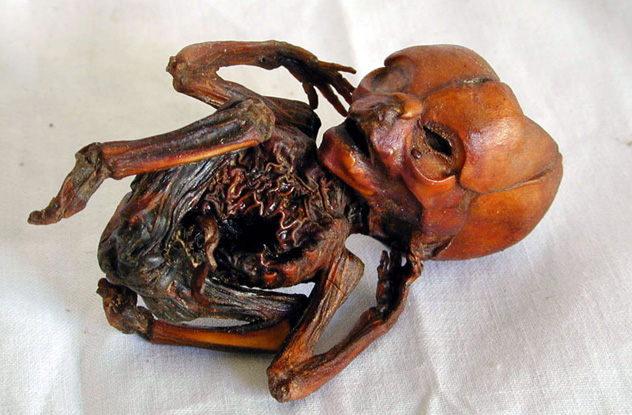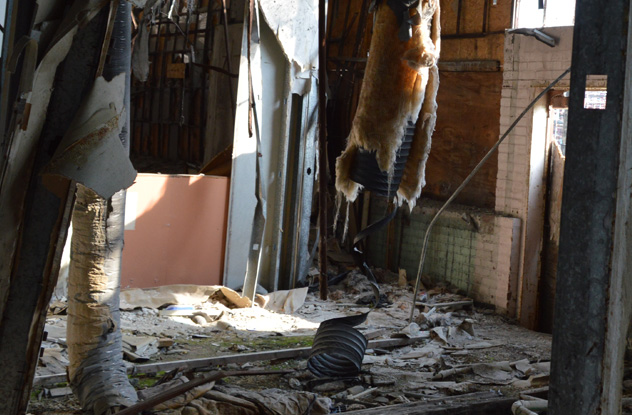 Mysteries
Mysteries  Mysteries
Mysteries  History
History 10 Surprising Stories About the Texas Rangers
 Humans
Humans 10 Philosophers Who Were Driven Mad by Their Own Theories
 Miscellaneous
Miscellaneous 10 Video-Game-Worthy Weapons and Armors from History
 Weird Stuff
Weird Stuff 10 Psychics Who Accurately Predicted Wartime Events
 The Arts
The Arts 10 Pieces of Art Inspired by a Broken Heart
 Health
Health 10 Science Fiction-Sounding New Medical Treatments
 History
History 10 Surprising Facts About the Father of Submarine Warfare
 Space
Space Ten Astonishing New Insights into Alien Worlds
 Weird Stuff
Weird Stuff 10 Bizarre Summer Solstice Rituals Still Practiced Today
 Mysteries
Mysteries Top 10 Haunting Facts About the Ghost Ship MV Alta
 History
History 10 Surprising Stories About the Texas Rangers
 Humans
Humans 10 Philosophers Who Were Driven Mad by Their Own Theories
Who's Behind Listverse?

Jamie Frater
Head Editor
Jamie founded Listverse due to an insatiable desire to share fascinating, obscure, and bizarre facts. He has been a guest speaker on numerous national radio and television stations and is a five time published author.
More About Us Miscellaneous
Miscellaneous 10 Video-Game-Worthy Weapons and Armors from History
 Weird Stuff
Weird Stuff 10 Psychics Who Accurately Predicted Wartime Events
 The Arts
The Arts 10 Pieces of Art Inspired by a Broken Heart
 Health
Health 10 Science Fiction-Sounding New Medical Treatments
 History
History 10 Surprising Facts About the Father of Submarine Warfare
 Space
Space Ten Astonishing New Insights into Alien Worlds
 Weird Stuff
Weird Stuff 10 Bizarre Summer Solstice Rituals Still Practiced Today
10 Bizarre Things People Did With Corpses
When most of us die, a few tears might be shed over our bodies. Within a few days, we will likely be buried or cremated, our physical form reduced to a mere memory. But some of us will continue on in our adventures. Below is a collection of stories about corpses that eschewed tradition, from crash test dummies to bodies that became drug paraphernalia.
10Corpses Of Stone

Mankind has been taken with the idea of preserving corpses. The oldest known mummy is that of a child of the Chinchorro people, a prehistoric fishing culture that lived along the arid coast of present-day Chile and Peru. It was carbon dated to approximately 5050 B.C., long before the Egyptians began their practice.
Born in 1792, Italian anatomist Girolamo Segato was rather obsessed with Egyptian funerary practices. He went on several archaeological expeditions to Egypt, where he became intimately acquainted with the process of mummification. Upon his return to Italy, Segato unveiled an extraordinary technique of preserving flesh—artificial petrifaction.
According to pioneering American surgeon Valentine Mott, who spent some time in Europe in the company of Segato, the Italian “had discovered a chemical process by which he could actually petrify, in very short time, every animal substance, preserving permanently, and with minute accuracy, its form and internal texture, and in such a state of stony hardness that it could be sawed into slabs and elegantly polished!”
Segato died in 1836, destroying all his notes before his passing. His collection of preserved remains was scattered, with the largest concentration located at the Museum of the Department of Anatomy in Florence. Despite extensive study, Segato’s petrification method remains a mystery to this day.
9Pickled Corpses

A half century before the Panama Canal was constructed, a railway was built to link the Atlantic and Pacific Oceans. The chief inspiration for this project was the California Gold Rush of 1849 and the mad rush to stake a claim to fortune. Men came from across the globe to work on the railway, many without any identification or known next of kin.
This feat of engineering would come at great cost to many—diseases like yellow fever, malaria, and cholera plagued the workers, and thousands died. A ban on opium caused many of the Chinese workers, who had become addicted to the drug in their homeland, to commit suicide. No official records were kept, but the death toll could have easily exceeded 10,000.
It might seem natural that the Panama Railroad Company would simply bury their dead and move on, but they had other plans. Keeping their eye on the bottom line, they pickled many of the corpses and sold them off to medical schools for experimentation. It was an exciting time in medicine—anesthesia had just been discovered, and surgeries, which had previously been hack jobs performed as swiftly as possible, became far more intricate. Bodies were in high demand, and for over five years, the Panama Railroad Company was a leading supplier.
8Corpse Bongs

Those given to the frequent consumption of marijuana are rarely lauded for the motivation. But potheads tend to have the engineering prowess of MacGyver when it comes to manufacturing smoking implements, utilizing everything from apples to soda cans. In 2008, three teens in Humble, Texas used a truly ghoulish method to get high. They dug up the grave of a child named Willie Simms who’d died in 1921, severed the corpse’s head, and used the skull as a bong.
The teens may very well have gotten away with this gruesome crime if they hadn’t later been caught during a vehicle break-in investigation. One of them confessed to desecrating Simms’s corpse. At first, the story seemed so bizarre that the police did not believe it, but a visit to the cemetery yielded a disturbed grave filled with rainwater, its headstone broken.
All three were charged with abuse of a corpse, a misdemeanor, along with other crimes.
7The Unclaimed Corpse Indicator

Funerals can be extraordinarily expensive. According to the National Funeral Directors Association, a traditional funeral and burial can easily approach $10,000. Even a comparatively cheap cremation exceeds $3,000.
In 2009, when the economy was in dire straits, cities across America reported a vast increase in unclaimed bodies, an indicator that the financial outlook of the nation was indeed grim. Los Angeles experienced a 36 percent rise in unclaimed dead over the previous fiscal year. Even in the most dire financial circumstances, most deceased are claimed by their loved ones, but in certain circumstances, it can be seen how a body could go unclaimed. Faced with the choice, would an impoverished single mother take on the staggering debt of burying a great uncle she’d never met?
One of the cities hardest hit by this phenomenon was Detroit, an area plagued by unemployment and poverty. Here, the state of Michigan pays for indigent burials, which cost $750 each. Unfortunately, these payments were rarely timely, as the state struggled through its own financial woes. Meanwhile, the unclaimed bodies piled up in refrigerated storage rooms. In October and November 2008, Michigan paid for 637 indigent burials. A year later, the economy tanked so badly that this number nearly doubled, swelling to 1,268 in the same time period.
6Audrey Mountford, The Jilted Bride

One of Charles Dickens’s most celebrated works is the novel Great Expectations, in which a boy is subjected to the sinister machinations of a jilted bride. Real life has its own strange tales of jilted brides, including Australian Audrey Mountford. Audrey fell in love with a Canadian man, and the two planned to marry. However, their union was not to be. Heartbroken, she left her home in Sydney in 1969.
Mountford frequently traveled and was described by her family as “flighty,” so though they looked for her, they didn’t worry that anything was amiss. It was believed that she had gone overseas to recover from the failed relationship. However, a teenager discovered her remains in a cave in Australia’s Blue Mountains in 1981. She wore her mother’s wedding ring and was surrounded by various items like toothpaste and utensils. The body could not be identified, and the case was dropped in 1983.
A coroner’s inquiry in July 2009 finally confirmed the fate of Audrey Mountford. Her family was devastated by the news. Her younger sister, 84-year-old Nola Stewart, had been the last family member to see Audrey alive. She said, “Actually it saddens me more to find out what happened to her because I thought that she was living somewhere and not bothering to get back in touch with me.”
5Corpse-Eating Robots

In the summer of 2009, headlines abounded with tales of military robots being designed to ingest human corpses as a power supply. The macabre creation called EATR™ (Energetically Autonomous Tactical Robot) could operate in perpetuity without refueling by consuming any available biomass in the area.
Cyclone Power Technologies Inc. and Robotic Technology Inc., which are developing the robots, were quick to point out that the “biomass” would not be flesh, human or otherwise, but rather vegetation. Cyclone’s CEO Harry Schoell said, “We completely understand the public’s concern about futuristic robots feeding on the human population, but that is not our mission. We are focused on demonstrating that our engines can create usable, green power from plentiful, renewable plant matter.”
Much of the American military concern is located in Middle Eastern deserts not particularly known for their lush vegetation. So it might not hurt to make a few tweaks that would allow the EATR to nibble a corpse or two, despite what the Geneva Conventions might say.
4Samuel Pepys’s Kiss

Samuel Pepys is a name you may recognize from history lessons. He was a member of parliament and naval administrator, but he is best remembered for his exhaustive diary, which gives us an important source on the English Reformation period. However, along with detailing events such as plagues and fires, the diary also offers a glimpse into Pepys’s social life, including details of liaisons with his mistress.
Perhaps the most bizarre entry comes from February 23, 1669, when Pepys and his family visited Westminster Abbey on the occasion of his 36th birthday. It reads in part, “Therefore I now took them to Westminster Abbey, and there did show them all the tombs very finely, having one with us alone, there being other company this day to see the tombs, it being Shrove Tuesday; and here we did see, by particular favour, the body of Queen Katherine of Valois; and I had the upper part of her body in my hands, and I did kiss her mouth, reflecting upon it that I did kiss a Queen, and that this was my birthday, thirty-six years old, that I did first kiss a Queen.”
Catherine of Valois was the wife of Henry V. She died in 1437 at the age of 35, shortly after childbirth. She’d been dead for over 230 years before Pepys’s romantic advances.
3Crash Test Dummies

Those of us who grew up in the 1980s probably remember the antics of Vince and Larry, the crash test dummies who taught us the importance of using seat belts. However, only so much can be learned from dummies—the potential for trauma in car crashes can only be truly gauged using real human bodies.
Cadaver research has been going on for decades, although automakers try to downplay their use. The National Highway Traffic Safety Administration, in conjunction with funding from automakers like Ford, conducts cadaver tests every year. Everything from seat belts to safety glass was first tested on cadavers, which could then be given X-rays and autopsies to determine exactly how flesh would respond in just such an incident.
Those with a squeamish bent will be pleased to learn that cadaver testing has declined significantly in recent years. The safety systems in most automobiles are about as good as they’re going to get, and most tests these days are done virtually using computer models.
2An Extra Leg

The 1995 bombing of Oklahoma City’s Alfred P. Murrah Federal Building was a devastating terrorist attack that killed at least 168 people. Among the dead was 21-year-old Lakesha Levy, a member of the Air Force who was at the building to pick up a Social Security card. After Levy’s body was buried, a severed leg was found in the rubble of the building. FBI tests found that the decomposed leg belonged to a black woman. A footprint determined that it belonged to Levy, even though she’d been buried with two legs.
Her body was subsequently exhumed, but officials were unable to determine just where this mystery leg came from. The body’s DNA had been destroyed by the embalming process. According to Oklahoma medical examiner Fred Jordan, “We don’t have a body to match it to. It’s something we haven’t figured out yet.”
1The Oldest Man In Japan

Japan’s kodokushi, or lonely deaths, are senior citizens who die and go undiscovered for long periods of time. This happens frequently in Japan, which has the most elderly population in the world. Perhaps the body to go longest undiscovered belonged to Sogen Kato, born on July 22, 1899.
In 2010, officials tried to contact Kato, wishing to honor him for his extreme longevity. His family rejected their advances, offering various excuses, including that Kato had become brain dead or that he was undergoing the Buddhist process of sokushinbutsu, or self-mummification, starving himself to death on the path to enlightenment.
Authorities persisted in trying to contact Kato. Police eventually broke into his home, discovering his mummified corpse lying in bed. Newspapers in the room indicated that Kato had likely died around November 1978, meaning that his body had been there for 32 years. Unlike the kodokushi, Kato’s family knew full well what had occurred but continued to collect his pension long after he had died. His daughter and granddaughter were charged with fraud.
The Kato case caused the Japanese government to launch a nationwide investigation to discover whether many of the country’s supposed centenarians are indeed still alive.
Mike Devlin is an aspiring novelist.








